A Thing of Beauty _|_ Issue 2, 2016
A Thing of Beauty…
Michael Hornsby visits the James Turrell’s installation at Dorotheenstädtischer Friedhof, Berlin
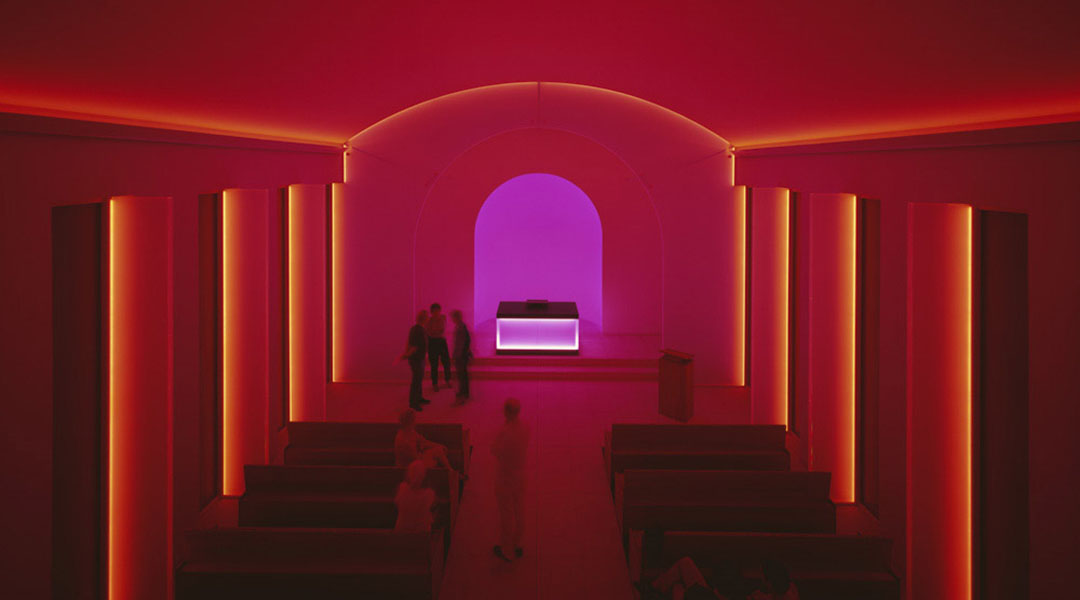

A Thing of Beauty…
Michael Hornsby visits the James Turrell’s installation at Dorotheenstädtischer Friedhof, Berlin
The American artist James Turrell has made his name as a master of light and space. This article describes one of his few permanent exhibits, where crowds gather at dusk every Monday and Saturday at a cemetery in Berlin to witness a mesmerising interplay of light and colour.
When the artist James Turrell was a young boy, his grandmother gave him some advice about what to do in the meetings they would attend as a Quaker family: “go inside, and greet the light”. Her words appear to have struck something of a chord. Today, Turrell is virtually synonymous with light art and his work is often discussed in terms of engendering sublime experiences [/] and representing a spiritual ‘inner’ light, as well as in terms of the science of light and our perception of it.
In recent years the veteran artist’s star has shone brighter than ever, with a trio of blockbuster museum shows held almost simultaneously across the United States in 2013, and a seemingly constant tour of his works around art venues across the globe. He is now even discussed in the most popular of cultural contexts, ever since the video Hotline Bling by the Canadian rapper Drake was said to draw inspiration from the white-cube Turrell light installations which have wowed crowds at the LA County Museum of Art, the Guggenheim in New York, and elsewhere.
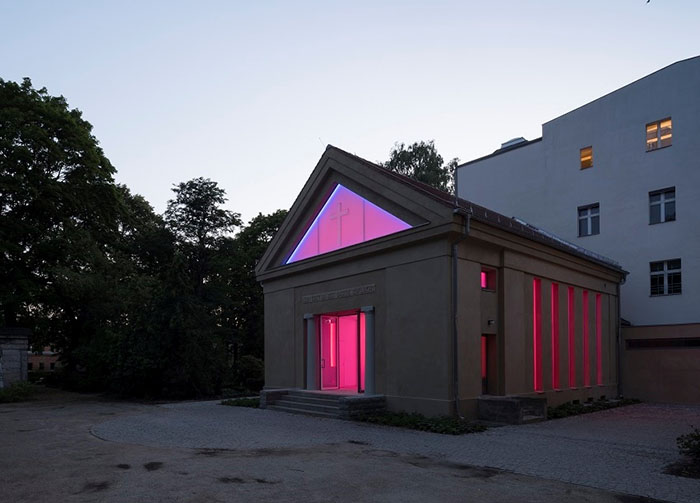
The exterior of the chapel at the Dorotheenstädtischer Friedhof cemetery. Photograph: Florian Holzherr
Amidst such hype, in the summer of 2015 Turrell completed a considerably more discreet project in a small chapel at Dorotheenstädtischer Graveyard in Berlin, the final resting place of such luminaries as Brecht and Hegel. Perhaps surprisingly for a city known for its love of contemporary art, the chapel is the only permanent installation by Turrell in Berlin. Since it opened, groups of visitors have quietly gathered there twice a week during the hour before sunset. Lined up on specially built oak pews, they watch a changing cycle of coloured light which floods the building from sources hidden within the walls, apse and altar.
The hour-long presentation allows plenty of time for thought and reflection. At times, the changes in colour are slow enough to be almost imperceptible. Moments when a single colour becomes dominant throughout the space feel like a dramatic event, like the explosion of a firework, silenced, and slowed down several thousand times. We are not used to being immersed in light coloured at its source rather than at the point of reflection, and one realises early on that it affects both our moods and perception differently: blue light feels both warmer and more comforting than red; an information sheet which appeared white at first turns out to be blue when the colours change.
As the daylight outside fades, we experience an indoor simulacrum of a sunset. Different areas in the chapel begin to glow in different colours, at one point calling to mind a tree-fringed field of hay under a darkening sky. Turrell has said that he is interested in capturing the kind of light we see in a lucid dream, and the presentation here seems like an invitation to venture inwards – all the more so for its explicitly religious setting. Any figurative art that had decorated the interior of the chapel has been stripped out during the refit for this installation. There is scarcely an object to look at; all that remains, tellingly, is a large bible lying open on the altar between two candles, above a simple but prominent crucifix.
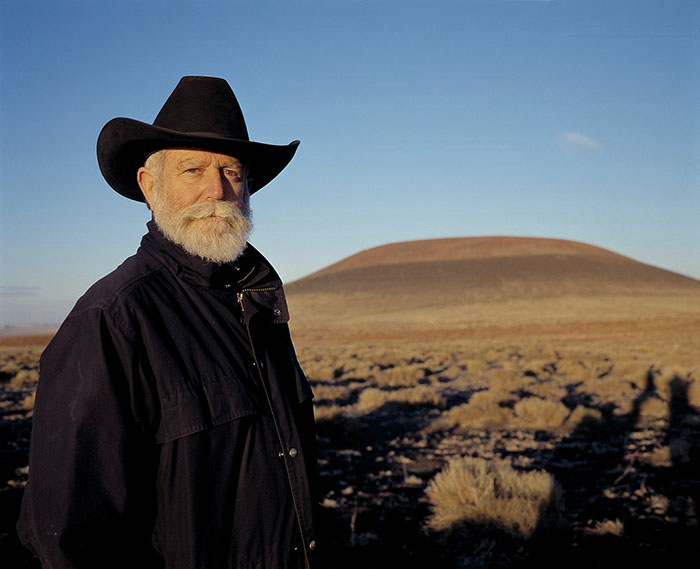
James Turrell. Photograph: Florian Holzherr
Much of Turrell’s other work, such as the architectural Skyspaces he has built around the world – from Kielder Forest in the north of England to the Israel Museum in Jerusalem or Roden Crater, his magnus opus in the Arizona dessert – seek to engender what Jane Carroll described in the 2014 Beshara Lecture [/] as “a profound and personal engagement with the sky, sun, moon and stars from a private position”. Here in Berlin, however, the invitation is clearly to something less cosmic and more personal, connected to the Quaker belief [/] in “the possibility of direct, unmediated communion with the Divine”. It feels like a guided meditation, or a silent liturgy. Turrell seems to be evoking our memories and emotions, asking us to reflect on them in the context of our understanding of the Divine which the religious artefacts on the altar represent.
In doing this, he relies on creating an effect similar to what Professor Roger Homan calls [/] “the original purpose of stained glass”:
[…] not the desire to illustrate but the need to sedate light. A stained glass window slows us down; it inclines us to proceed reverently and lower our voices. It is atmospheric. In churches and cathedrals it speaks as the voice in the burning bush “the place whereon thou standest is holy ground”.
Indeed, when I visited the chapel the audience was almost completely silent until, after more than half an hour, the caretaker announced that it was quite alright to walk around or talk to one another. A few of us went closer to the walls, looking for the physical source of light. Some stepped outside to see the building glowing from within through its tall and narrow windows. But most stayed inside on their pew, exchanging little more than a quiet word or two with their neighbour.
Becoming aware of how reverent the atmosphere had been until then, it occurred to me that since I had arrived, the entire environment had heightened my expectation of feeling something profound. Was this a deliberate ruse – an attempt by the artist to show how easily manipulated we are by sense or symbol, to deconstruct the religious belief in a higher power? In Turrell’s case, it seems unlikely. Rather, it seems that he is taking advantage of visitors’ increased receptivity in this setting in order to generate an especially meaningful interaction between the public and his work.
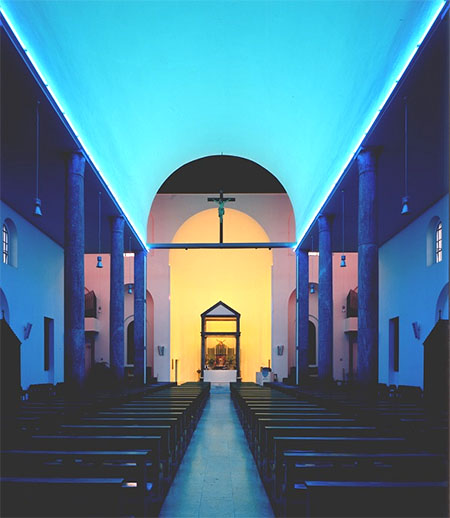
Don Flavin’s installation at the Chiesa Rossa in Milan. Photograph courtesy of Paola Bobba and the Fondazine Prada, Milano
Shortly after first visiting the chapel in Berlin, I saw a picture of a visually similar installation which Dan Flavin had made at Chiesa Rossa in Milan. Flavin had fitted the church with neon lights which, like Turrell’s cycle, suggest a progression from daylight through sunset to night. Unlike Turrell, however, Flavin consistently rejected any symbolic interpretation of his work; for him, it was always about transforming the space and nothing more – although some people have speculated that this church project, completed near the end of his life, may represent a return to faith of sorts.
It seems unlikely that Turrell is not familiar with Flavin’s installation, and thinking about the two installations together, I was reminded that he once said in an interview: “segregating the literal and what we call the ‘spiritual’ can sometimes be a meaningless distinction”. No doubt some visitors to Chiesa Rossa find great symbolism and meaning in Flavin’s glowing neon lights there, perhaps against the artist’s best intentions. Similarly, others will surely visit Dorotheenstädtischer Friedhof and be moved by its architectural aspect most of all, because the reverse of Turrell’s point is also true: to ignore the literal component from something ‘spiritual’ is to stop short of fully understanding it. In a very real sense, the hushed veneration in Turrell’s Berlin chapel is nothing more than a trick of the light. But this points to an important truth. An artist can set us in a certain direction, but we have to “go inside and greet the light” on our own.

The chapel in blue light. Photograph: Florian Holzherr
Image Sources (click to open)
Banner picture: The chapel bathed in red light. Photograph by Florian Holzherr.
Other Sources (click to open)
ROGER HOMAN: “Who looks on glass? The Spiritual Significance of Stained Glass” in Social Affairs Unit blog [/]
Our thanks to Florian Holzherr, Paola Bobba and the Fondazine Prada, Milano, for the images used in this article.
Email this page to a friend
FOLLOW AND LIKE US
——————————————
——————————————
——————————————
FOLLOW AND LIKE US
If you enjoyed reading this article
Please leave a comment below.
Please also consider making a donation to support the work of Beshara Magazine. The magazine relies entirely on voluntary support. Donations received through this website go towards editorial expenses, eg. image rights, travel expenses, and website maintenance and development costs.
READ MORE IN BESHARA MAGAZINE

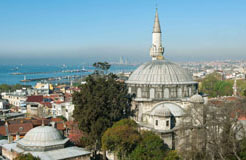
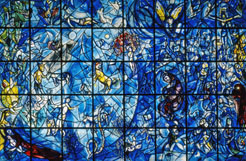
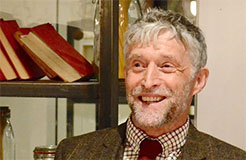
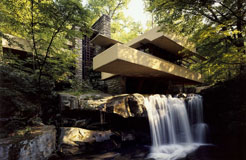
READERS’ COMMENTS
0 Comments